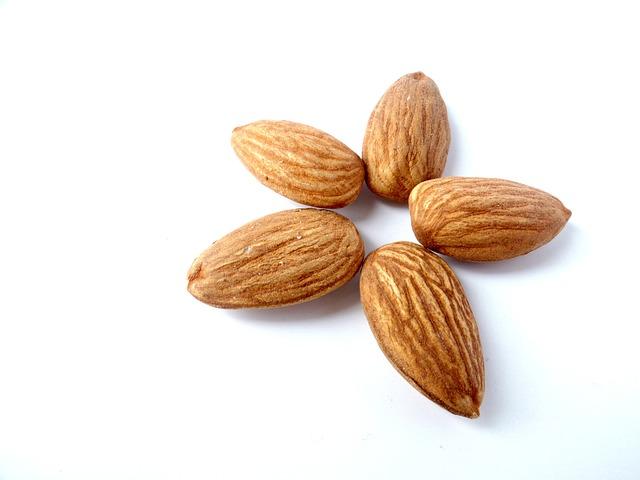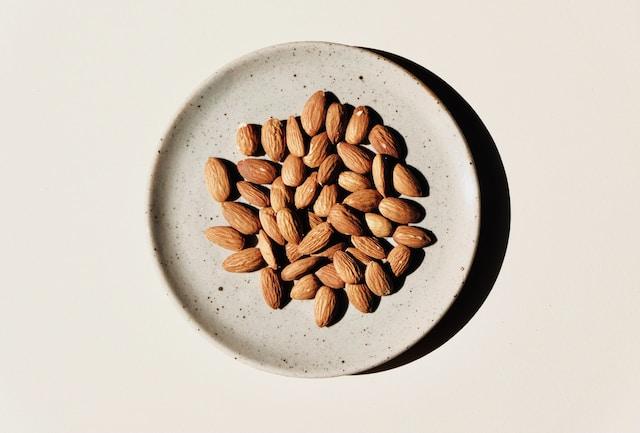The almond tree (Prunus dulcis), produces pretty little pinkish-white flowers, of which only one in three will produce an almond.Fresh or green almonds are harvested by hand from late June to early July.This marvellous nut is an essential health treasure.
My favorite varieties with almonds
Although the almond tree originated in Asia, today it can be found on every continent.A large part of the almonds that we consume comes from the United States, more specifically California, which with its 250,000 tonnes per year is far ahead of other producer countries.
France lags far behind with barely 1,000 tonnes.Depending on the climate, we still have several interesting almond varieties, such as Ferragnès, Mandaline and Ferraduel.I'd also mention the Lauranne variety, which produces large almonds perfect for making sugared almonds or praline-based recipes. And let's not forget the rustic varieties with charming names that we sometimes find in our gardens, such as Pointue d'Aureille, Princesse or Madame Dupuis.
Several small local producers produce exceptional almonds.
Here are just a few examples:
- En Provence
- In the Gard
- En Pyrénées-Orientales
Many are in the South, but you may be lucky enough to find one near you.
Almonds are highly nutritious, but not fattening
Les almonds can be eaten fresh from the field, or dried when the husk turns brown and opens.We often hear that almonds are fattening. In fact, they are very high in calories (around 600 kcal per 100 g), and contain a good deal of fat. But almonds are actually a great way to lose weight!
Several studies attest to this.In one of them, two types of diet were tested on overweight people, some of whom were diabetics:
- one enriched with almonds
- and the other in complex carbohydrates for 24 weeks.
Both diets naturally provided the same number of calories and the same amount of protein.Both diets enabled participants to lose weight, but the diet based on almonds has proved far more effective.
- -18% versus -11% for BMI (body weight index), -14% versus -9% for waist circumference, and -30% versus -20% for body fat.
- In the almond group, blood pressure was lowered and insulin resistance improved.
- Similar results were measured in another study.
The low-calorie diets planned for the two groups of overweight people were identical, with the exception of the almond group, which ate 50g of almonds a day.
In terms of weight loss, BMI, waist circumference, total cholesterol and triglycerides, fasting blood glucose and blood pressure, the almond group achieved significantly better results.
A number of factors probably play in almonds' favor, including the fact that although they contain a lot of fat, not all of it is absorbed.

In fact, if you take the time to chew them carefully, lipid extraction is only 9 and 12% respectively for roasted and raw almonds. What's more, if you're looking to lose weight, they're very satiating and rich in fiber (if you have transit problems, think about it).
A handle almonds (i.e. around 30 grams) is always preferable to a chocolate bar when you're feeling peckish.
So don't hesitate to treat yourself!
Three good reasons to snack on almonds
Almonds provide our bodies with many nutrients essential for good health: phytosterols, mono- and polyunsaturated fatty acids, proteins, fiber and minerals (notably calcium, magnesium and phosphorus).
According to research, adding a daily ration of almonds to your diet can have a beneficial effect on your health:
Cardiovascular
The majority of lipids in almonds are monounsaturated or polyunsaturated fatty acids.These quality fats are very beneficial to the cardiovascular system.
Several studies have shown that almonds reduce LDL cholesterol levels (considered bad cholesterol) while increasing HDL levels (good cholesterol).
A diet enriched with almonds would therefore be a good strategy for combating dyslipidemia, a major risk factor for coronary heart disease.This could be linked to the quantity of phytosterols (the famous good-for-you lipids).
The latter have a chemical structure very similar to that of cholesterol, and compete with it in the digestion of fats.In a way, they regulate cholesterol levels, favoring the good over the not-so-good.
Le diabète
One study highlighted the fact that almond improves symptoms of hyperglycemia and depression in patients with type 27 diabetes. With a diet low in sugar and enriched in almondsThe results were convincing after just three months.In particular, the researchers noted an improvement in intestinal flora, which could explain the results.
Although few similar studies have been carried out, it is now well established that a diet combining fresh fruit and oilseeds (noix, almondshazelnuts, etc.) helps prevent and control type 28 diabetes.
Et la dépression
It is also well documented that a diet rich in a variety of nuts helps to moderate the symptoms of depression and combat cognitive disorders.
Are almonds eaten with or without the skin?
It's in the thin skin of almonds that the most antioxidants and vitamins are found.It is precisely when it is eaten whole that almond is not completely crushed by our mastication. This explains why a good proportion of lipids remain trapped in the material and cannot be fully assimilated by our bodies.
So when you're on a diet, remember that skin is even better!On the other hand, if you have intestinal fragility, it is preferable to consume the almonds without the skin, which is difficult to digest.
Easy on the bitterness of the almond...
Les almonds sweet almonds are the most common and widely eaten, but some of you may also enjoy bitter almonds.They are mainly used as flavoring or liqueur in pastries and cocktails.
If you happen to eat them, do so in moderation, as they contain a toxic substance: amygdalin.
Once in the body, amygdalin transforms into cyanide.Even a small ingestion of cyanide can cause symptoms such as vomiting, headaches and dizziness, and in large doses it is highly toxic.So be careful.
Almond panna cotta
When it comes to enjoying the full benefits ofalmondIt is best eaten raw.In fact, during cooking, temperature alters the vitamins, fatty acids and proteins of which it is composed.What's more, most almonds are cooked in the wrong fats.
This recipe comes from the website : Going green with Lili Je l'ai découverte il y a déjà quelque temps et je l'apprécie particulièrement. I hope this creamy panna cotta with mashedalmond the papillae are barely visible.
Ingredients (for 4)
- 250 ml almond cream
- 150 ml warm water
- 2 tablespoons white almond purée
- 4 tbsp. wholemeal sugar
- 1 tablespoon cornstarch
- 1.5 g agar-agar
- 8 pecans

- Pour all the ingredients, except the pecans, into a saucepan.
- Slowly bring to the boil, stirring regularly with a whisk.
- When the mixture has boiled for 2 minutes, turn off the heat and stir one last time.
- Pour the cream into ramekins and chill in the fridge for 2 hours.
- Just before serving, crumble 2 crushed pecans over each panna cotta. For an even more delicious treat, pour a little maple syrup over the top.
Finally, a few recommendations:
- Don't eat your almonds after the best-before date to limit the risk of contamination with aflatoxins (toxins dangerous to health).
- Les almonds are nuts. They should therefore be avoided by allergy sufferers. Beware of potential allergic reactions in children. In case of suspected allergy after ingestion, call a doctor.
- People with swallowing problems and children must be particularly vigilant as the almonds can cause choking hazards.
- Finally, always prefer almonds unprocessed (not roasted, salted or flavoured), which are much healthier.



